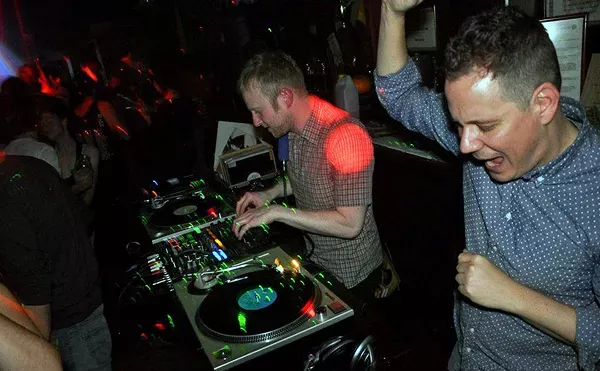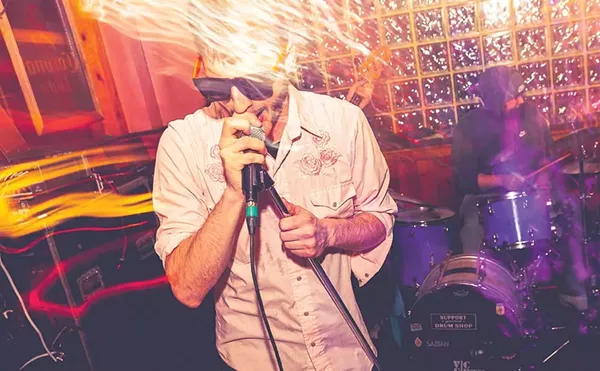The world is a safer place for artful tomfoolery because of the Residents. For 30 years now, the troupe (musicians? artists? vaudevillians?) has willfully dodged easy classification and cultural ossification with its music, multimedia art and elaborate stage performances. But their most telling legacy and perhaps their most slippery attribute is their conceptual underpinning of willful anonymity and identity puckishness at play in pop music.
Now that the Residents have turned 30, one might be tempted even to look at them as a mirror-ball reflection of the hollow representation of counterculture that is the Rolling Stones. The nascent Residents came together in ’66, have recorded a deconstructed take on “Satisfaction,” branched into the many-tentacled media arena, struggled with their corporate handlers and generally have become an “institution.” But while Mick and Keef are faintly glimmering twin pillars of the cult of personality, the Residents are by their own choice without identity (but not without persona). Better still, they’ve aged more gracefully and have been as influential on the musical underground as the Stones have been on cock rock.
So it’s obvious that to even begin to get a handle on the Residents’ wildly diverse career, one needs to take it one step at a time.
After all, what is one to make of a “band” that throws pretty much every major pop and high-art and musical movement — from fluxus and surrealism to the blues and marching bands — into its equal-opportunity art machine?
The Residents themselves, of course, won’t provide such an easy handle on their work. They are still the iconic-yet-anonymous tricksters in tuxedos (with eyeballs for heads) that have refused steadfastly to grant interviews. The Residents have better things to do with their time. So we must address such rudimentary inquiries to the group’s corporate front, the tellingly named Cryptic Corporation.
When we asked Cryptic Corp.’s Homer Flynn whether the Residents are even a “band,” he responded in kind: “By whose definition? We need a control ‘band’ to compare them to. Are they like the Beatles? Nope. We think of them as a ‘group’ or even ‘troupe’ when touring.”
So that’s a start.
When asked why it’s still important, even after 30 years, to maintain airtight (at least in the media) anonymity, Flynn counters: “I don’t think age changes a basically good idea. The problem is that more performers don’t keep their faces out of our lives.”
You can begin to see why the Residents are the sort of band that overzealous music writers trip over each other to gush about. (And why art-rock nerds still seek solace in their grooves.)
They first unleashed their idiosyncratic vision on the world via 1974’s Meet the Residents. The San Francisco-based outfit laid down out-there sound collages, whacked lyrical funsense and, at its core, a thoroughly twisted vision of rock ’n’ roll.
They have since recorded a vast body of work that takes in John Philip Sousa, send-ups of cracker country, smirking takes on funk and more colors in a musical palette than their Dada workouts can sometimes incorporate.
That they’ve never really found a spot in Casey Kasem’s charts shouldn’t be a surprise, but the Residents have thankfully kept at it, making the world a safer place for us all artistically. Their latest effort, Demons Dance Alone, is a mellower affair that recalls the work of Brecht or the weirder side of cult crooner Scott Walker. Their press materials note that the record is in some form a reaction to the events of Sept. 11, 2001.
Flynn elaborates: “The Residents have been made to feel very sad for the state of the world and sometimes think humans are not the best species to run things. Maybe things were better under dinosaur rule.”
The music, in and of itself, would have been enough to make ’em cult faves. But the Residents’ create live presentations that are over-the-top theatrical events, embracing their video work, left-field rock vaudeville and the latest, greatest homemade, reconfigured and store-bought musical technologies. Their previous tour was a “greatest hits” affair — a Residents revue, if you will.
This time around, says Flynn, the Residents’ performance “will be a normal show ... actually it will be anything but ‘normal.’ [It will be] much more fun than normal.”
The Residents, always early adapters of new technologies, have created award-winning (and brain-bending — see the 1996 CD-ROM Bad Day at the Midway) works with new media toys. Indeed, these monkeyshines have become such a part of their working method that Flynn’s a bit flummoxed when asked how the Web has changed the Residents’ methods.
“I’ll just say that is a massive change,” he says. “The Residents, ever lovers of manipulating, are greatly empowered by doing so on the subatomic level.”
So has the Web at least made reaching out to potential new Residents fans and the rest of the world an easier task?
“I’m doing this interview on my PowerBook by e-mail while sitting next to a swimming pool in San Diego. That should answer that question.”
So there you have it — a view into the Residents’ storm. Like the music-crit equivalent of a high hanging curveball, everyone wants a swing at cracking their myth over the fence. But ultimately, the Residents’ beauty is in the eyeball of the beholder.
The Residents will perform an all-ages show Friday, Nov. 8 at the Majestic Theater (4140 Woodward, Detroit). For information, call 313-833-9700.
Chris Handyside is a freelance writer for Metro Times. Send comments to letters@metrotimes.com





